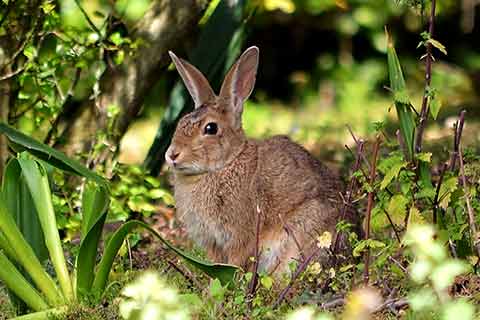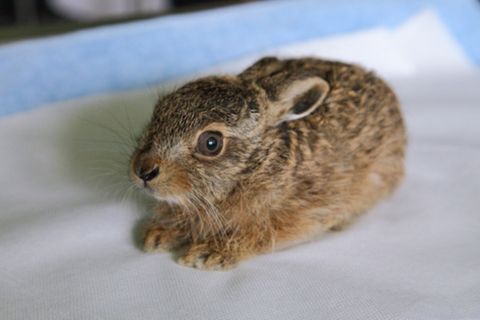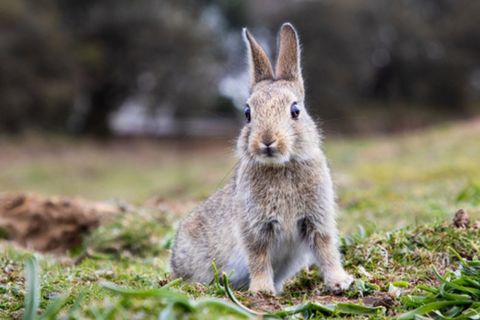What's the difference between a rabbit and a hare?
Rabbits are about half the size of hares when they’re fully grown. It can be hard to tell the difference between rabbits and hares when they’re very young, but it’s important so you know what to do if they do need help.
- Baby rabbits (kittens) have beige fur and pink skin around their nose, but baby hares (leverets) have dark fur and black skin around the nose.
- Hares have black tips to their ears, and longer ears and legs than rabbits
- Baby rabbits will be born blind and without fur, and they’ll stay in their burrow until they’re about three weeks old and look like mini adults. Their mother will come back each day to feed them.
- Baby hares are born with eyes open and a full coat of fur, and they’re left alone by their mother from a very young age. They live out in the open, in a shallow hole in the ground. During the day, their mother will stay nearby to watch over them and she’ll come back to feed them at night.

Found an injured or sick rabbit?
Myxomatosis is a very infectious disease which is widespread in our wild rabbits. It can also affect pet rabbits if they come into contact with wild rabbits. Sadly, there is no cure for this disease and it’s usually fatal.
Symptoms of myxomatosis include
- Lumps on the head and body
- Swelling around the lips, nose, eyes and ears and their back end
- Runny eyes
- Pus coming from the nose and eyes
- Another disease that can infect wild and pet rabbits is called Rabbit (Viral) Haemorrhagic Disease. It acts quickly, so rabbits may not show any signs of infection until it’s too late.
If you find a wild rabbit that you think might have these diseases, or any other illness or injury, the best thing to do is to contact a vet.
Unfortunately, a lot of the time, sick or injured wild animals are in a very bad state by the time they can be caught, and the kindest thing for the vet to do is to put the animal to sleep, so please be prepared that they may need to take that difficult decision.
To transport the animal, make sure you’re wearing thick protective gloves when you’re handling the rabbit, and use one hand to support their strong back legs. You can confine the rabbit by carefully placing a towel over it, and putting it in a plastic box or carrier.
Found a baby rabbit or hare?
If you find a baby rabbit or hare alone, they might not have been abandoned. Each year, lots of baby animals are taken into wildlife centres by people who want to help them, but often the best thing to do is leave them alone. Animals take better care of their babies than humans can, so we should only rescue them as a last resort.
It’s normal for baby hares to be left alone for long periods of time, even when they’re very young. Their mother will usually come back around dusk to feed them. However, baby rabbits will stay in their burrow until they’re about three weeks old, so if you see them above ground before this age then they will need help.

When a rabbit or hare needs to be rescued immediately
- They’re injured
- They’ve been caught by a dog or cat
- They are covered with flies’ eggs (these look like small grains of rice)
- Their eyes are closed, or they’re not covered in fur. This will be a baby rabbit that’s been dug out of the warren, so check for any other baby rabbits nearby
- You can see their mother is dead nearby. A mother rabbit or hare will have bald patches on her chest where the babies feed
If they don't require immediate rescue
- If it’s in danger, move the animal to a safe place a very short distance away. Put the animal on the ground, somewhere sheltered such as under a plant.
- Move about 100 metres away, and watch the animal from a distance to see what happens.
- If it’s a young rabbit, it will make its own way back to the burrow when it’s ready.
- If it’s a young hare, it will stay very still, even if you watch for a while, because it’s waiting for mum to return. The mother will be nearby, waiting for you to leave and she may not come back if you stay too close or make lots of noise.
- The best thing to do is to leave the animal alone. Don’t touch them, stay very quiet and make sure any pets are kept away.
- If the baby rabbit or hare is still there two hours after sunset and the mother hasn’t come back for the babies, they will need to be rescued.

How to handle and transport
If you need to rescue a baby rabbit or hare, make sure you wear gloves and handle them for as short a time as possible. Put the animal into a cardboard box lined with towels, with a hot water bottle to keep them warm. Make sure the bottle is wrapped in a towel so they can’t get burnt. Please don’t try to give them food or water, as this can do more harm than good.
Keep them in a quiet, warm place away from pets, and contact a vet as soon as you can. Don’t try to look after them yourself, they’re wild animals and they need specialist care to give them the best chance of surviving back in the wild. The care they need is very different to how pet rabbits are looked after, and they can also pass diseases to pets.




